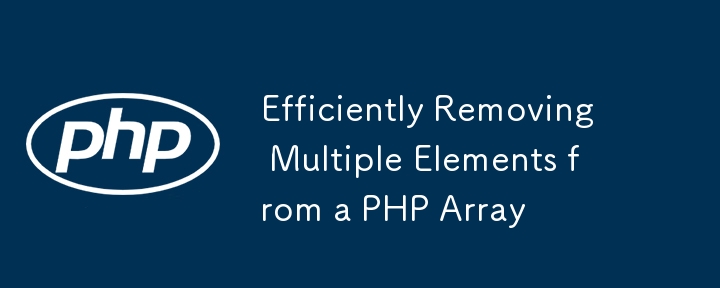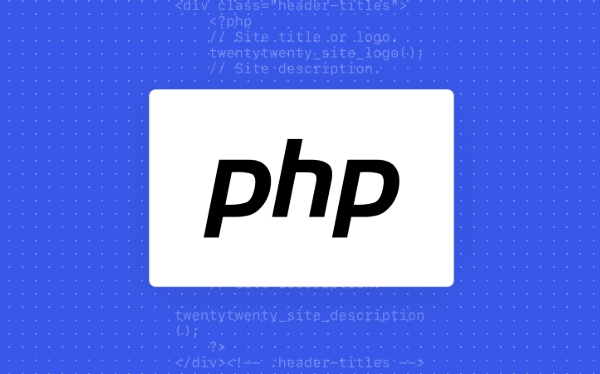Efficiently Removing Multiple Elements from a PHP Array
Aug 02, 2025 pm 01:22 PMTo efficiently remove multiple elements in PHP array, you should choose the appropriate method according to the removal conditions: 1. Use array_diff() to remove elements through values, which is suitable for deletion of known values in one-dimensional arrays. Pay attention to the key name preservation, and use array_values() to reindex; 2. Use unset() loop or array_diff_key() to remove elements through keys. The former is simple and efficient, while the latter needs to implement functional programming style with array_flip(); 3. Use array_filter() to filter elements according to conditions, such as removing empty values, non-strings or items that meet specific logic, return false to indicate removal, and true to indicate retention; 4. Use array_unique() to remove duplicate values, which is fast and retains key names, and reindex with array_values() if necessary; 5. Performance optimization recommendations include avoiding nested loops, prioritizing built-in functions, and reindex only if needed. In short, selecting the corresponding function based on the removal can effectively complete the array cleaning.

When working with arrays in PHP, you may often need to remove multiple elements based on specific criteria—such as their values, keys, or conditions like duplicates or empty entries. While PHP doesn't have a single built-in function to remove multiple elements in all contexts, there are several efficient and clean approaches depending on your use case.

Here's how to effectively remove multiple elements from a PHP array:
1. Remove Elements by Value Using array_diff()
If you want to remove elements based on their values, array_diff() is a fast and clean solution.

$array = ['apple', 'banana', 'cherry', 'date']; $to_remove = ['banana', 'date']; $result = array_diff($array, $to_remove);
Results:
['apple', 'cherry']
? Best for: Removing known values from a one-dimensional array.
?? Note: Keys are preserved but not reindexed. Usearray_values()to reindex:$result = array_values(array_diff($array, $to_remove));
2. Remove Elements by Key Using unset() or array_diff_key()
When you know the keys to remove, use unset() in a loop or array_diff_key() for a functional approach.
Option A: Using unset() in a loop (simple and fast)
$array = ['a' => 1, 'b' => 2, 'c' => 3, 'd' => 4];
$keys_to_remove = ['b', 'd'];
foreach ($keys_to_remove as $key) {
unset($array[$key]);
} Option B: Using array_diff_key() (functional style)
$keys_to_remove = ['b', 'd']; $result = array_diff_key($array, array_flip($keys_to_remove));
? Best for: associated arrays where you want to remove by key.
?? Usearray_flip()to convert the list of keys into an associated array expected byarray_diff_key().
3. Remove Elements Based on a Condition with array_filter()
Use array_filter() when you need logic—like removing empty values, numbers below a threshold, or strings matching a pattern.
$array = [0, 1, 2, '', null, 'hello', 'world'];
// Remove false values
$result = array_filter($array);
// Remove elements that are not strings
$result = array_filter($array, 'is_string');
// Custom condition: remove strings shorter than 5 characters
$result = array_filter($array, function($item) {
return is_string($item) && strlen($item) >= 5;
});? Best for: conditional filtering.
? Returnfalseto remove,trueto keep.
4. Remove Duplicates with array_unique()
If the goal is to remove duplicate values:
$array = [1, 2, 2, 3, 3, 3]; $result = array_unique($array);
? Fast and built-in. Preserves keys—reindex if needed with
array_values().
5. Performance Tips
- For large arrays, avoid nested loops. Stick to built-in functions like
array_diff,array_filter, orarray_diff_key. - Reindex only when necessary (eg, after
array_diff) usingarray_values(). - Use
unset()in loops for key-based removal—it's often faster than functional alternatives for small key sets.
Summary of Best Methods
| Goal | Recommended Function |
|---|---|
| Remove by value | array_diff()
|
| Remove by key | unset() or array_diff_key()
|
| Conditional removal | array_filter()
|
| Remove duplicates | array_unique()
|
Use the right tool based on whether you're filtering by value, key, or logic. Most of these methods are efficient and readable, making array cleanup in PHP straightforward. Basically, match the function to your removal criteria and you're good to go.
The above is the detailed content of Efficiently Removing Multiple Elements from a PHP Array. For more information, please follow other related articles on the PHP Chinese website!

Hot AI Tools

Undress AI Tool
Undress images for free

Undresser.AI Undress
AI-powered app for creating realistic nude photos

AI Clothes Remover
Online AI tool for removing clothes from photos.

Clothoff.io
AI clothes remover

Video Face Swap
Swap faces in any video effortlessly with our completely free AI face swap tool!

Hot Article

Hot Tools

Notepad++7.3.1
Easy-to-use and free code editor

SublimeText3 Chinese version
Chinese version, very easy to use

Zend Studio 13.0.1
Powerful PHP integrated development environment

Dreamweaver CS6
Visual web development tools

SublimeText3 Mac version
God-level code editing software (SublimeText3)

Hot Topics
 PHP Variable Scope Explained
Jul 17, 2025 am 04:16 AM
PHP Variable Scope Explained
Jul 17, 2025 am 04:16 AM
Common problems and solutions for PHP variable scope include: 1. The global variable cannot be accessed within the function, and it needs to be passed in using the global keyword or parameter; 2. The static variable is declared with static, and it is only initialized once and the value is maintained between multiple calls; 3. Hyperglobal variables such as $_GET and $_POST can be used directly in any scope, but you need to pay attention to safe filtering; 4. Anonymous functions need to introduce parent scope variables through the use keyword, and when modifying external variables, you need to pass a reference. Mastering these rules can help avoid errors and improve code stability.
 How to handle File Uploads securely in PHP?
Jul 08, 2025 am 02:37 AM
How to handle File Uploads securely in PHP?
Jul 08, 2025 am 02:37 AM
To safely handle PHP file uploads, you need to verify the source and type, control the file name and path, set server restrictions, and process media files twice. 1. Verify the upload source to prevent CSRF through token and detect the real MIME type through finfo_file using whitelist control; 2. Rename the file to a random string and determine the extension to store it in a non-Web directory according to the detection type; 3. PHP configuration limits the upload size and temporary directory Nginx/Apache prohibits access to the upload directory; 4. The GD library resaves the pictures to clear potential malicious data.
 Commenting Out Code in PHP
Jul 18, 2025 am 04:57 AM
Commenting Out Code in PHP
Jul 18, 2025 am 04:57 AM
There are three common methods for PHP comment code: 1. Use // or # to block one line of code, and it is recommended to use //; 2. Use /.../ to wrap code blocks with multiple lines, which cannot be nested but can be crossed; 3. Combination skills comments such as using /if(){}/ to control logic blocks, or to improve efficiency with editor shortcut keys, you should pay attention to closing symbols and avoid nesting when using them.
 How Do Generators Work in PHP?
Jul 11, 2025 am 03:12 AM
How Do Generators Work in PHP?
Jul 11, 2025 am 03:12 AM
AgeneratorinPHPisamemory-efficientwaytoiterateoverlargedatasetsbyyieldingvaluesoneatatimeinsteadofreturningthemallatonce.1.Generatorsusetheyieldkeywordtoproducevaluesondemand,reducingmemoryusage.2.Theyareusefulforhandlingbigloops,readinglargefiles,or
 Tips for Writing PHP Comments
Jul 18, 2025 am 04:51 AM
Tips for Writing PHP Comments
Jul 18, 2025 am 04:51 AM
The key to writing PHP comments is to clarify the purpose and specifications. Comments should explain "why" rather than "what was done", avoiding redundancy or too simplicity. 1. Use a unified format, such as docblock (/*/) for class and method descriptions to improve readability and tool compatibility; 2. Emphasize the reasons behind the logic, such as why JS jumps need to be output manually; 3. Add an overview description before complex code, describe the process in steps, and help understand the overall idea; 4. Use TODO and FIXME rationally to mark to-do items and problems to facilitate subsequent tracking and collaboration. Good annotations can reduce communication costs and improve code maintenance efficiency.
 Quick PHP Installation Tutorial
Jul 18, 2025 am 04:52 AM
Quick PHP Installation Tutorial
Jul 18, 2025 am 04:52 AM
ToinstallPHPquickly,useXAMPPonWindowsorHomebrewonmacOS.1.OnWindows,downloadandinstallXAMPP,selectcomponents,startApache,andplacefilesinhtdocs.2.Alternatively,manuallyinstallPHPfromphp.netandsetupaserverlikeApache.3.OnmacOS,installHomebrew,thenrun'bre
 Learning PHP: A Beginner's Guide
Jul 18, 2025 am 04:54 AM
Learning PHP: A Beginner's Guide
Jul 18, 2025 am 04:54 AM
TolearnPHPeffectively,startbysettingupalocalserverenvironmentusingtoolslikeXAMPPandacodeeditorlikeVSCode.1)InstallXAMPPforApache,MySQL,andPHP.2)Useacodeeditorforsyntaxsupport.3)TestyoursetupwithasimplePHPfile.Next,learnPHPbasicsincludingvariables,ech
 How to access a character in a string by index in PHP
Jul 12, 2025 am 03:15 AM
How to access a character in a string by index in PHP
Jul 12, 2025 am 03:15 AM
In PHP, you can use square brackets or curly braces to obtain string specific index characters, but square brackets are recommended; the index starts from 0, and the access outside the range returns a null value and cannot be assigned a value; mb_substr is required to handle multi-byte characters. For example: $str="hello";echo$str[0]; output h; and Chinese characters such as mb_substr($str,1,1) need to obtain the correct result; in actual applications, the length of the string should be checked before looping, dynamic strings need to be verified for validity, and multilingual projects recommend using multi-byte security functions uniformly.







